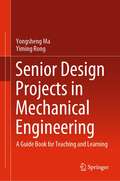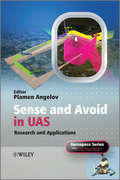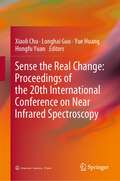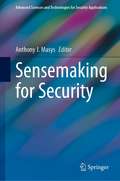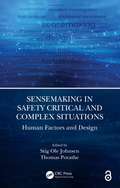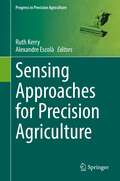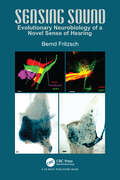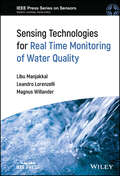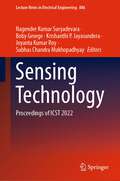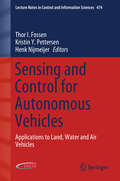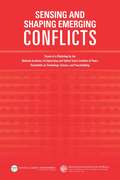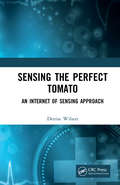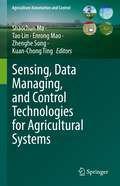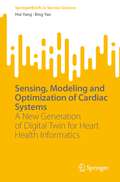- Table View
- List View
Senior Design Projects in Mechanical Engineering: A Guide Book for Teaching and Learning
by Yongsheng Ma Yiming RongThis book offers invaluable insights about the full spectrum of core design course contents systematically and in detail. This book is for instructors and students who are involved in teaching and learning of ‘capstone senior design projects’ in mechanical engineering.It consists of 17 chapters, over 300 illustrations with many real-world student project examples.The main project processes are grouped into three phases, i.e., project scoping and specification, conceptual design, and detail design, and each has dedicated two chapters of process description and report content prescription, respectively. The basic principles and engineering process flow are well applicable for professional development of mechanical design engineers.CAD/CAM/CAE technologies are commonly used within many project examples. Thematic chapters also cover student teamwork organization and evaluation, project management, design standards and regulations, and rubrics of course activity grading. Key criteria of successful course accreditation and graduation attributes are discussed in details. In summary, it is a handy textbook for the capstone design project course in mechanical engineering and an insightful teaching guidebook for engineering design instructors.
Sense and Avoid in UAS
by Plamen AngelovThere is increasing interest in the potential of UAV (Unmanned Aerial Vehicle) and MAV (Micro Air Vehicle) technology and their wide ranging applications including defence missions, reconnaissance and surveillance, border patrol, disaster zone assessment and atmospheric research. High investment levels from the military sector globally is driving research and development and increasing the viability of autonomous platforms as replacements for the remotely piloted vehicles more commonly in use.UAV/UAS pose a number of new challenges, with the autonomy and in particular collision avoidance, detect and avoid, or sense and avoid, as the most challenging one, involving both regulatory and technical issues. Sense and Avoid in UAS: Research and Applications covers the problem of detect, sense and avoid in UAS (Unmanned Aircraft Systems) in depth and combines the theoretical and application results by leading academics and researchers from industry and academia.Key features:Presents a holistic view of the sense and avoid problem in the wider application of autonomous systemsIncludes information on human factors, regulatory issues and navigation, control, aerodynamics and physics aspects of the sense and avoid problem in UASProvides professional, scientific and reliable content that is easy to understand, andIncludes contributions from leading engineers and researchers in the fieldSense and Avoid in UAS: Research and Applications is an invaluable source of original and specialised information. It acts as a reference manual for practising engineers and advanced theoretical researchers and also forms a useful resource for younger engineers and postgraduate students. With its credible sources and thorough review process, Sense and Avoid in UAS: Research and Applications provides a reliable source of information in an area that is fast expanding but scarcely covered.
Sense the Real Change: Proceedings of the 20th International Conference on Near Infrared Spectroscopy
by Xiaoli Chu Yue Huang Longhai Guo Hongfu YuanThis book features selected papers presented at the 20th International Conference on Near Infrared Spectroscopy. It discusses the latest progress in the field of near infrared spectroscopy from around the globe, including the advances in instrumentation, spectral interpretation and Chemometrics. In addition, it presents potential trends for near infrared spectroscopy in the next decade and highlights developments in process analytical technology, chemical imaging and deep learning. It can be used as a reference book for researchers and application personnel engaged in spectroscopy technology, Chemometrics, analytical instruments, on-site rapid or on-line analysis, process control and other fields. It will also be useful for undergraduates and postgraduates studying these topics.
Sensemaking for Security (Advanced Sciences and Technologies for Security Applications)
by Anthony J. MasysThis book presents sensemaking strategies to support security planning and design. Threats to security are becoming complex and multifaceted and increasingly challenging traditional notions of security. The security landscape is characterized as ‘messes’ and ‘wicked problems’ that proliferate in this age of complexity. Designing security solutions in the face of interconnectedness, volatility and uncertainty, we run the risk of providing the right answer to the wrong problem thereby resulting in unintended consequences. Sensemaking is the activity that enables us to turn the ongoing complexity of the world into a “situation that is comprehended explicitly in words and that serves as a springboard into action” (Weick, Sutcliffe, Obstfeld, 2005). It is about creating an emerging picture of our world through data collection, analysis, action, and reflection. The importance of sensemaking to security is that it enables us to plan, design and act when the world as we knew it seems to have shifted. Leveraging the relevant theoretical grounding and thought leadership in sensemaking, key examples are provided, thereby illustrating how sensemaking strategies can support security planning and design. This is a critical analytical and leadership requirement in this age of volatility, uncertainty, complexity and ambiguity that characterizes the security landscape. This book is useful for academics, graduate students in global security, and government and security planning practitioners.
Sensemaking in Elementary Science: Supporting Teacher Learning (Teaching and Learning in Science Series)
by Elizabeth A. Davis Carla Zembal-Saul Sylvie M. KademianGrounded in empirical research, this book offers concrete pathways to direct attention towards elementary science teaching that privileges sensemaking, rather than isolated activities and vocabulary. Outlining a clear vision for this shift using research-backed tools, pedagogies, and practices to support teacher learning and development, this edited volume reveals how teachers can best engage in teaching that supports meaningful learning and understanding in elementary science classrooms. Divided into three sections, this book demonstrates the skills, knowledge bases, and research-driven practices necessary to make a fundamental shift towards a focus on students’ ideas and reasoning, and covers topics such as: An introduction to sensemaking in elementary science; Positioning students at the center of sensemaking; Planning and enacting investigation-based science discussions; Designing a practice-based elementary teacher education program; Reflections on science teacher education and professional development for reform-based elementary science. In line with current reform efforts, including the Next Generation Science Standards (NGSS), Sensemaking in Elementary Science is the perfect resource for graduate students and researchers in science education, elementary education, teacher education, and STEM education looking to explore effective practice, approaches, and development within the elementary science classroom.
Sensemaking in Safety Critical and Complex Situations: Human Factors and Design
by Stig Ole Johnsen Thomas PoratheSensemaking in Safety Critical and Complex Situations: Human Factors and Design Human factors-based design that supports the strengths and weaknesses of humans are often missed during the concept and design of complex technical systems. With the focus on digitalization and automation, the human actor is often left out of the loop but needs to step in during safety-critical situations. This book describes how human factors and sensemaking can be used as part of the concept and design of safety critical systems in order to improve safety and resilience. This book discusses the challenges of automation and automated systems when humans are left out of the loop and then need to intervene when the situation calls for it. It covers human control and accepts that humans must handle the unexpected and describes methods to support this. It is based on recent accident analysis involving autonomous systems that move our understanding forward and supports a more modern view on human errors to improve safety in industries such as shipping and marine. The book is for human factors and ergonomists, safety engineers, designers involved in safety critical work and students. Stig Ole Johnsen is a Senior Researcher at SINTEF in Norway. He has a PhD from NTNU in Norway with a focus on resilience in complex socio-technical systems and has a Master’s in Technology Management from MIT/NTNU. He chairs the Human Factors in Control network (HFC) in Norway to strengthen the human factors focus during development and implementation of safety critical technology. His research interests include meaningful human control to support safety and resilience during automation and digitalization. Thomas Porathe has a degree in Information Design from Malardalen University in Sweden. He is currently Professor of Interaction Design at the Norwegian University of Science and Technology in Trondheim, Norway. He specializes in maritime human factors and design of maritime information systems, specifically directed towards control room design, e-navigation and autonomous ships. He has been working with e-Navigation since 2006 in EU projects such as BLAST, EfficienSea, MONALISA, ACCSEAS, SESAME and the unmanned ship project MUNIN. He is active in the International Association of Aids to Navigation and Lighthouse Authorities (IALA).
Sensing Approaches for Precision Agriculture (Progress in Precision Agriculture)
by Ruth Kerry Alexandre EscolàSensing Approaches for Precision Agriculture aims to bring together the ‘state of the art’ of the most popular sensing techniques and the current state of research on the application of sensors in Precision Agriculture (PA). Sensing is of great value in PA because it provides cheap and immediate data for management. This book gives a broad overview of sensing in PA and a coherent introduction for new professionals and research scientists. Readers are introduced to the potential applications of a range of different sensors, how they should be used properly and their limitations for use in PA. Chapters on specific topics and case studies provide depth and enable implementation of the methods by users. A general introduction about sensing techniques in PA is followed by Chapters 2–9 on the most important specific techniques in sensing and Chapters 10–13 include mini-case studies, each showing cutting-edge applications for different sensing methods. Finally, there is an Epilogue on how we expect sensors and analysis to develop.
Sensing Emotions
by Martijn Krans Martin Ouwerkerk Joyce WesterinkIn the future, products and machines will know how we feel and how to adapt to those feelings. This book analyzes the influence of specific everyday situations and contexts on the emotional state of people and ways this will impact future user experience.
Sensing Machines: How Sensors Shape Our Everyday Life
by Chris SalterHow we are tracked, surveilled, tantalized, and seduced by machines ranging from smart watches and Roombas to immersive art installations.Sensing machines are everywhere in our world. As we move through the day, electronic sensors and computers adjust our thermostats, guide our Roombas, count our steps, change the orientation of an image when we rotate our phones. There are more of these electronic devices in the world than there are people—in 2020, thirty to fifty billion of them (versus 7.8 billion people), with more than a trillion expected in the next decade. In Sensing Machines, Chris Salter examines how we are tracked, surveilled, tantalized, and seduced by machines ranging from smart watches and mood trackers to massive immersive art installations. Salter, an artist/scholar who has worked with sensors and computers for more than twenty years, explains that the quantification of bodies, senses, and experience did not begin with the surveillance capitalism practiced by Facebook, Amazon, Netflix, and Google but can be traced back to mathematical and statistical techniques of the nineteenth century. He describes the emergence of the &“sensed self,&” investigating how sensor technology has been deployed in music and gaming, programmable and immersive art environments, driving, and even eating, with e-tongues and e-noses that can taste and smell for us. Sensing technology turns our experience into data; but Salter&’s story isn&’t just about what these machines want from us, but what we want from them—new sensations, the thrill of the uncanny, and magic that will transport us from our daily grind.
Sensing Sound: Evolutionary Neurobiology of a Novel Sense of Hearing
by Bernd FritzschHearing is a prerequisite for the evolution of language and thus the development of human societies. It is the only major sense whose evolution can be traced back to vertebrates, starting with sarcopterygians. The book explores the evolution of auditory development that has remained largely unexplored in contemporary theories of neurosensory brain evolution, including the telencephalon. It describes how sensory epithelia from the basilar papilla evolved in the ear and connected dedicated cochlear neurons to neuronal centers in the brain, and deals with how sound is converted through sound modulations into reliably decoded messages. The loss of hearing with age is expected to reach 2.6 billion people by 2050. As such, the book explains and reviews hearing loss at the molecular level to the behavioral level, and provides suggestions to manage the loss.
Sensing Technologies For Precision Irrigation
by Dejan Vukobratovic Marta Alonso Fernandez Vladan Minic Dubravko Ćulibrk Vladimir Crnojevic Javier Alvarez OsunaThis brief provides an overview of state-of-the-art sensing technologies relevant to the problem of precision irrigation, an emerging field within the domain of precision agriculture. Applications of wireless sensor networks, satellite data and geographic information systems in the domain are covered. This brief presents the basic concepts of the technologies and emphasizes the practical aspects that enable the implementation of intelligent irrigation systems. The authors target a broad audience interested in this theme and organize the content in five chapters, each concerned with a specific technology needed to address the problem of optimal crop irrigation. Professionals and researchers will find the text a thorough survey with practical applications.
Sensing Technologies for Field and In-House Crop Production: Technology Review and Case Studies (Smart Agriculture #7)
by Zhao Zhang Man Zhang Han Li Wenyi Sheng Ruicheng QiuThis book focuses on state-of-the-art sensing and automation technologies for field crops and in-house product production and provides a lot of innovative knowledge on image processing, AI algorithms and applications in agriculture, and robotics. This book provides undergraduate or graduate students with take-away knowledge for unmanned agricultural production, including but not limited to corn disease detection, wheat head detection and counting, and soil nutrient condition monitoring. The first three chapters focus on reviewing plant phenotyping sensing technology and robotics and soil nutrient monitoring, followed by in-house crop sensing robotics. Then two case studies on corn and the other two case studies on wheat are presented.
Sensing Technologies for Real Time Monitoring of Water Quality (IEEE Press Series on Sensors)
by Magnus Willander Libu Manjakkal Leandro LorenzelliSensing Technologies for Real Time Monitoring of Water Quality A comprehensive guide to the development and application of smart sensing technologies for water quality monitoring With contributions from a panel of experts on the topic, Sensing Technologies for Real Time Monitoring of Water Quality offers an authoritative resource that explores a complete set of sensing technologies designed to monitor, in real-time, water quality including agriculture. The contributing authors explore the fundamentals of sensing technologies and review the most recent advances of various materials and sensors for water quality??monitoring. This comprehensive resource includes information on a range of designs of smart electronics, communication systems, packaging, and innovative implementation approaches used for remote monitoring of water quality in various atmospheres. The book explores a variety of techniques for online water quality monitoring including internet of Things (IoT), communication systems, and advanced sensor deployment methods. This important book: Puts the spotlight on the potential capabilities and the limitations of various sensing technologies and wireless systems Offers an evaluation of a variety of sensing materials, substrates, and designs of sensors Describes sensor implementation in agriculture and extreme environments Includes information on the common characteristics, ideas, and approaches of water quality and quantity management Written for students and practitioners/researchers in water quality management, Sensing Technologies for Real Time Monitoring of Water Quality offers, in one volume, a guide to the real time sensing techniques that can improve water quality and its management.
Sensing Technology: Current Status and Future Trends II
by Subhas Chandra Mukhopadhyay Alex Mason Krishanthi Padmarani Jayasundera Nabarun BhattacharyyaThis book is written for academic and industry professionals working in the field of sensing, instrumentation and related fields, and is positioned to give a snapshot of the current state of the art in sensing technology, particularly from the applied perspective. The book is intended to give broad overview of the latest developments, in addition to discussing the process through which researchers go through in order to develop sensors, or related systems, which will become more widespread in the future.
Sensing Technology: Proceedings of ICST 2022 (Lecture Notes in Electrical Engineering #886)
by Subhas Chandra Mukhopadhyay Krishanthi P. Jayasundera Boby George Joyanta Kumar Roy Nagender Kumar SuryadevaraThis book gathers the latest advances, innovations, and applications in the field of sensing technology, as presented by international researchers and engineers at the 14th International Conference on Sensing Technology (ICST), held in Chennai, India on January 17-19, 2022. Contributions include a wide range of topics such as: vision sensing, sensor signal processing, sensors phenomena and modelling, sensor characterization, smart sensors and sensor fusion, electromagnetic, chemical and physical sensors, electronic nose technology, biosensors, nano sensors, wireless sensors and WSN, Internet of Things, optical sensors, sensor arrays, intelligent sensing, Internet-based and remote data acquisition. The contributions, which were selected by means of a rigorous international peer-review process, present a wealth of exciting ideas that will open novel research directions and foster multidisciplinary collaboration among different specialists.
Sensing Technology: Proceedings of ICST'15 (Lecture Notes in Electrical Engineering #1035)
by Subhas Chandra Mukhopadhyay Krishanthi P. Jayasundera Boby George Nagender Kumar SuryadevaraThis book gathers the latest advances, innovations, and applications in the field of sensing technology, as presented by international researchers and engineers at the 15th International Conference on Sensing Technology (ICST), held in Sydney, Australia on December 5–7, 2022. Contributions include a wide range of topics such as: vision sensing, sensor signal processing, sensors phenomena and modelling, sensor characterization, smart sensors and sensor fusion, electromagnetic, chemical and physical sensors, electronic nose technology, biosensors, nano sensors, wireless sensors and WSN, Internet of Things, optical sensors, sensor arrays, intelligent sensing, Internet-based and remote data acquisition. The contributions, which were selected by means of a rigorous international peer-review process, present a wealth of exciting ideas that will open novel research directions and foster multidisciplinary collaboration among different specialists.
Sensing Vehicle Conditions for Detecting Driving Behaviors (Springerbriefs In Electrical And Computer Engineering)
by Yingying Chen Jiadi Yu Xiangyu XuThis SpringerBrief begins by introducing the concept of smartphone sensing and summarizing the main tasks of applying smartphone sensing in vehicles. Chapter 2 describes the vehicle dynamics sensing model that exploits the raw data of motion sensors (i.e., accelerometer and gyroscope) to give the dynamic of vehicles, including stopping, turning, changing lanes, driving on uneven road, etc. Chapter 3 detects the abnormal driving behaviors based on sensing vehicle dynamics. Specifically, this brief proposes a machine learning-based fine-grained abnormal driving behavior detection and identification system, D3, to perform real-time high-accurate abnormal driving behaviors monitoring using the built-in motion sensors in smartphones.As more vehicles taking part in the transportation system in recent years, driving or taking vehicles have become an inseparable part of our daily life. However, increasing vehicles on the roads bring more traffic issues including crashes and congestions, which make it necessary to sense vehicle dynamics and detect driving behaviors for drivers. For example, sensing lane information of vehicles in real time can be assisted with the navigators to avoid unnecessary detours, and acquiring instant vehicle speed is desirable to many important vehicular applications. Moreover, if the driving behaviors of drivers, like inattentive and drunk driver, can be detected and warned in time, a large part of traffic accidents can be prevented. However, for sensing vehicle dynamics and detecting driving behaviors, traditional approaches are grounded on the built-in infrastructure in vehicles such as infrared sensors and radars, or additional hardware like EEG devices and alcohol sensors, which involves high cost. The authors illustrate that smartphone sensing technology, which involves sensors embedded in smartphones (including the accelerometer, gyroscope, speaker, microphone, etc.), can be applied in sensing vehicle dynamics and driving behaviors. Chapter 4 exploits the feasibility to recognize abnormal driving events of drivers at early stage. Specifically, the authors develop an Early Recognition system, ER, which recognize inattentive driving events at an early stage and alert drivers timely leveraging built-in audio devices on smartphones. An overview of the state-of-the-art research is presented in chapter 5. Finally, the conclusions and future directions are provided in Chapter 6.
Sensing and Artificial Intelligence Solutions for Food Manufacturing
by Daniel HefftThis book gives readers a practical introduction into machine learning and sensing techniques, their design and ultimately specific applications that could improve food production. It shows how these sensing and computing systems are suitable for process implementation in food factories. This book starts by giving the reader an overview of the historic structures of food manufacturing standards and how they defined today’s manufacturing. It is followed by a topical introduction for professionals in the food industries in topics such as AI, machine learning, and neural networks. It also includes an explanation of the different sensor systems and their basic principles. It shows how these sensing and computing systems are suitable for process implementation in food factories and what types of sensing systems have already been proven to deliver benefit to the food manufacturing industries. The authors also discuss issues around food safety, labelling, and traceability and how sensing and AI can help to resolve issues. They also use case studies and specific examples that can show the benefit of such technologies compared to current approaches. This book is a practical introduction and handbook for students, food engineers, technologists and process engineers on the benefits and challenges around modern manufacturing systems following Industry 4.0 approaches.
Sensing and Control for Autonomous Vehicles
by Kristin Y. Pettersen Henk Nijmeijer Thor I. FossenThis edited volume includes thoroughly collected on sensing and control for autonomous vehicles. Guidance, navigation and motion control systems for autonomous vehicles are increasingly important in land-based, marine and aerial operations. Autonomous underwater vehicles may be used for pipeline inspection, light intervention work, underwater survey and collection of oceanographic/biological data. Autonomous unmanned aerial systems can be used in a large number of applications such as inspection, monitoring, data collection, surveillance, etc. At present, vehicles operate with limited autonomy and a minimum of intelligence. There is a growing interest for cooperative and coordinated multi-vehicle systems, real-time re-planning, robust autonomous navigation systems and robust autonomous control of vehicles. Unmanned vehicles with high levels of autonomy may be used for safe and efficient collection of environmental data, for assimilation of climate and environmental models and to complement global satellite systems. The target audience primarily comprises research experts in the field of control theory, but the book may also be beneficial for graduate students.
Sensing and Shaping Emerging Conflicts
by Steve Olson National Academy of Engineering United States Institute of Peace Andrew RobertsonTechnology has revolutionized many aspects of modern life, from how businesses operate, to how people get information, to how countries wage war. Certain technologies in particular, including not only cell phones and the Internet but also satellites, drones, and sensors of various kinds, are transforming the work of mitigating conflict and building peaceful societies. Rapid increases in the capabilities and availability of digital technologies have put powerful communications devices in the hands of most of the world's population. These technologies enable one-to-one and one-to-many flows of information, connecting people in conflict settings to individuals and groups outside those settings and, conversely, linking humanitarian organizations to people threatened by violence. Communications within groups have also intensified and diversified as the group members use new technologies to exchange text, images, video, and audio. Monitoring and analysis of the flow and content of this information can yield insights into how violence can be prevented or mitigated. In this way technologies and the resulting information can be used to detect and analyze, or sense, impending conflict or developments in ongoing conflict. On October 11, 2012, the National Academy of Engineering (NAE) and the United States Institute of Peace (USIP) held a workshop in Washington, DC, to identify "major opportunities and impediments to providing better real-time information to actors directly involved in situations that could lead to deadly violence." The workshop brought together experts in technology, experts in peacebuilding, and people who have worked at the intersections of those two fields on the applications of technology in conflict settings, to consider uses of technology to sense emerging and ongoing conflicts and provide information and analyses that can be used to prevent violent and deadly conflict. Sensing and Shaping Emerging Conflicts: Report of a Joint Workshop of the National Academy of Engineering and the United States Institute of Peace: Roundtable on Technology, Science, and Peacebuilding summarizes the workshop.
Sensing of Non-Volatile Memory Demystified
by Swaroop GhoshThis book introduces readers to the latest advances in sensing technology for a broad range of non-volatile memories (NVMs). Challenges across the memory technologies are highlighted and their solutions in mature technology are discussed, enabling innovation of sensing technologies for future NVMs. Coverage includes sensing techniques ranging from well-established NVMs such as hard disk, flash, Magnetic RAM (MRAM) to emerging NVMs such as ReRAM, STTRAM, FeRAM and Domain Wall Memory will be covered.
Sensing the Perfect Tomato: An Internet of Things Approach
by Denise WilsonTomatoes are an important crop for their economic value and nutritional benefits. Optimizing yields for tomato crops requires careful attention to how and when to harvest both in the context of time-to-market and end use. The Internet of Things (IOT), when using distributed and networked sensors, has shown tremendous potential to support precision agriculture, providing a finer resolution, more detailed picture of crops that was not previously possible using conventional crop monitoring techniques. This book marries the potential of the Internet of Sensors to the needs of tomato farming, in ways that are economically fruitful, technologically robust, and environmentally sustainable.
Sensing, Data Managing, and Control Technologies for Agricultural Systems (Agriculture Automation and Control)
by Tao Lin Shaochun Ma Enrong Mao Zhenghe Song Kuan-Chong TingAgricultural automation is the emerging technologies which heavily rely on computer-integrated management and advanced control systems. The tedious farming tasks had been taken over by agricultural machines in last century, in new millennium, computer-aided systems, automation, and robotics has been applied to precisely manage agricultural production system. With agricultural automation technologies, sustainable agriculture is being developed based on efficient use of land, increased conservation of water, fertilizer and energy resources. The agricultural automation technologies refer to related areas in sensing & perception, reasoning & learning, data communication, and task planning & execution. Since the literature on this diverse subject is widely scattered, it is necessary to review current status and capture the future challenges through a comprehensive monograph.In this book we focus on agricultural automation and provide critical reviews of advanced control technologies, their merits and limitations, application areas and research opportunities for further development. This collection thus serves as an authoritative treatise that can help researchers, engineers, educators, and students in the field of sensing, control, and automation technologies for production agriculture.
Sensing, Modeling and Optimization of Cardiac Systems: A New Generation of Digital Twin for Heart Health Informatics (SpringerBriefs in Service Science)
by Hui Yang Bing YaoThis book reviews the development of physics-based modeling and sensor-based data fusion for optimizing medical decision making in connection with spatiotemporal cardiovascular disease processes. To improve cardiac care services and patients’ quality of life, it is very important to detect heart diseases early and optimize medical decision making. This book introduces recent research advances in machine learning, physics-based modeling, and simulation optimization to fully exploit medical data and promote the data-driven and simulation-guided diagnosis and treatment of heart disease. Specifically, it focuses on three major topics: computer modeling of cardiovascular systems, physiological signal processing for disease diagnostics and prognostics, and simulation optimization in medical decision making. It provides a comprehensive overview of recent advances in personalized cardiac modeling by integrating physics-based knowledge of the cardiovascular system with machine learning and multi-source medical data. It also discusses the state-of-the-art in electrocardiogram (ECG) signal processing for the identification of disease-altered cardiac dynamics. Lastly, it introduces readers to the early steps of optimal decision making based on the integration of sensor-based learning and simulation optimization in the context of cardiac surgeries. This book will be of interest to researchers and scholars in the fields of biomedical engineering, systems engineering and operations research, as well as professionals working in the medical sciences.
Sensitive Matter
by Michel MitovLife would not exist without sensitive, or soft, matter. All biological structures depend on it, including red blood globules, lung fluid, and membranes. So do industrial emulsions, gels, plastics, liquid crystals, and granular materials. What makes sensitive matter so fascinating is its inherent versatility. Shape-shifting at the slightest provocation, whether a change in composition or environment, it leads a fugitive existence. Physicist Michel Mitov brings drama to molecular gastronomy (as when two irreconcilable materials are mixed to achieve the miracle of mayonnaise) and offers answers to everyday questions, such as how does paint dry on canvas, why does shampoo foam better when you âeoerepeat,âe#157; and what allows for the controlled release of drugs? Along the way we meet a futurist cook, a scientist with a runaway imagination, and a penniless inventor named Goodyear who added sulfur to latex, quite possibly by accident, and created durable rubber. As Mitov demonstrates, even religious ritual is a lesson in the surprising science of sensitive matter. Thrice yearly, the reliquary of St. Januarius is carried down cobblestone streets from the Cathedral to the Church of St. Clare in Naples. If all goes as hopedâe"and since 1389 it often hasâe"the dried blood contained in the reliquaryâe(tm)s largest vial liquefies on reaching its destination, and Neapolitans are given a reaffirming symbol of renewal.
